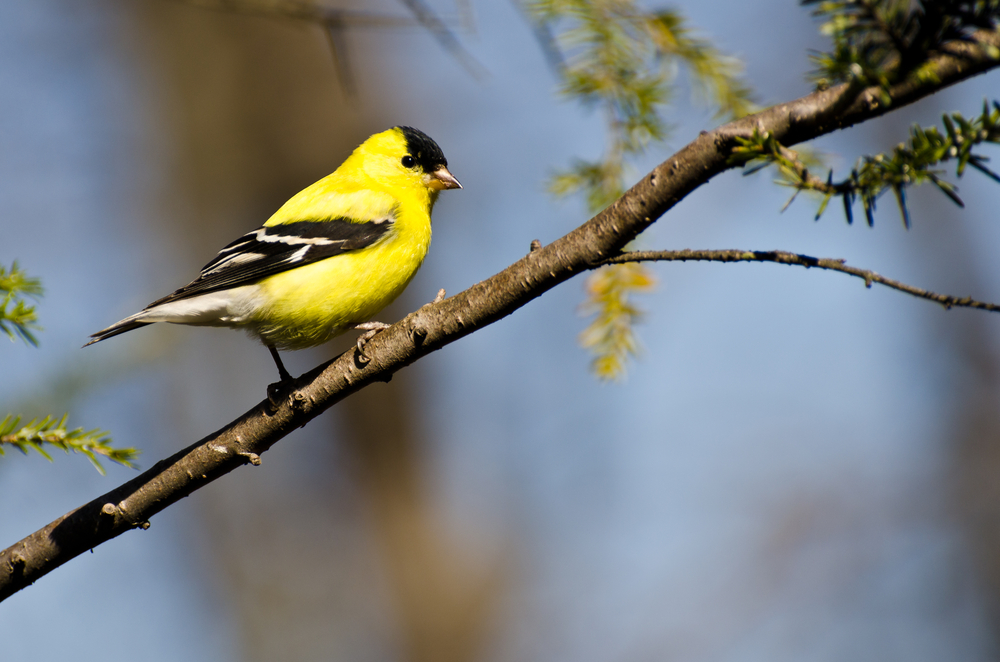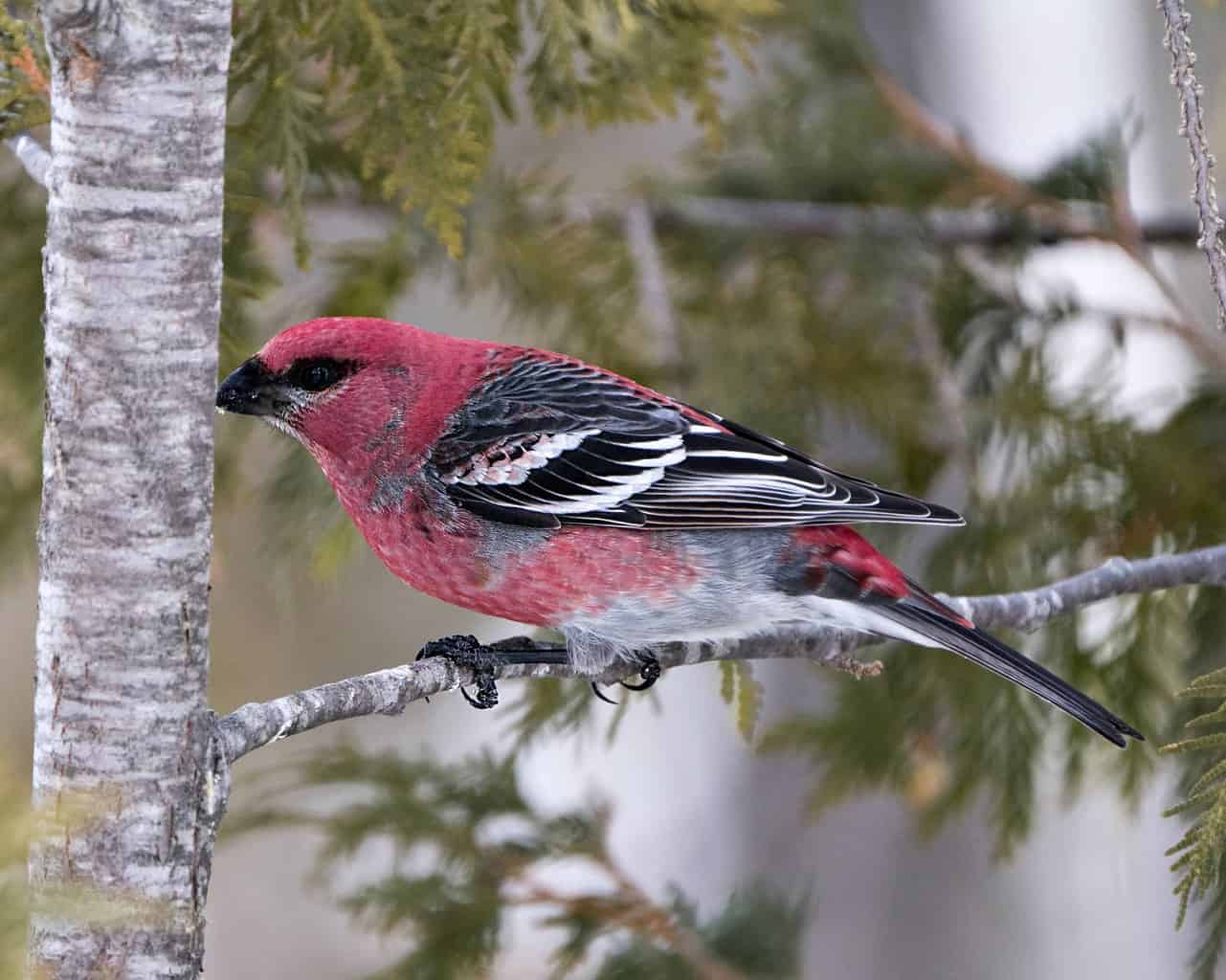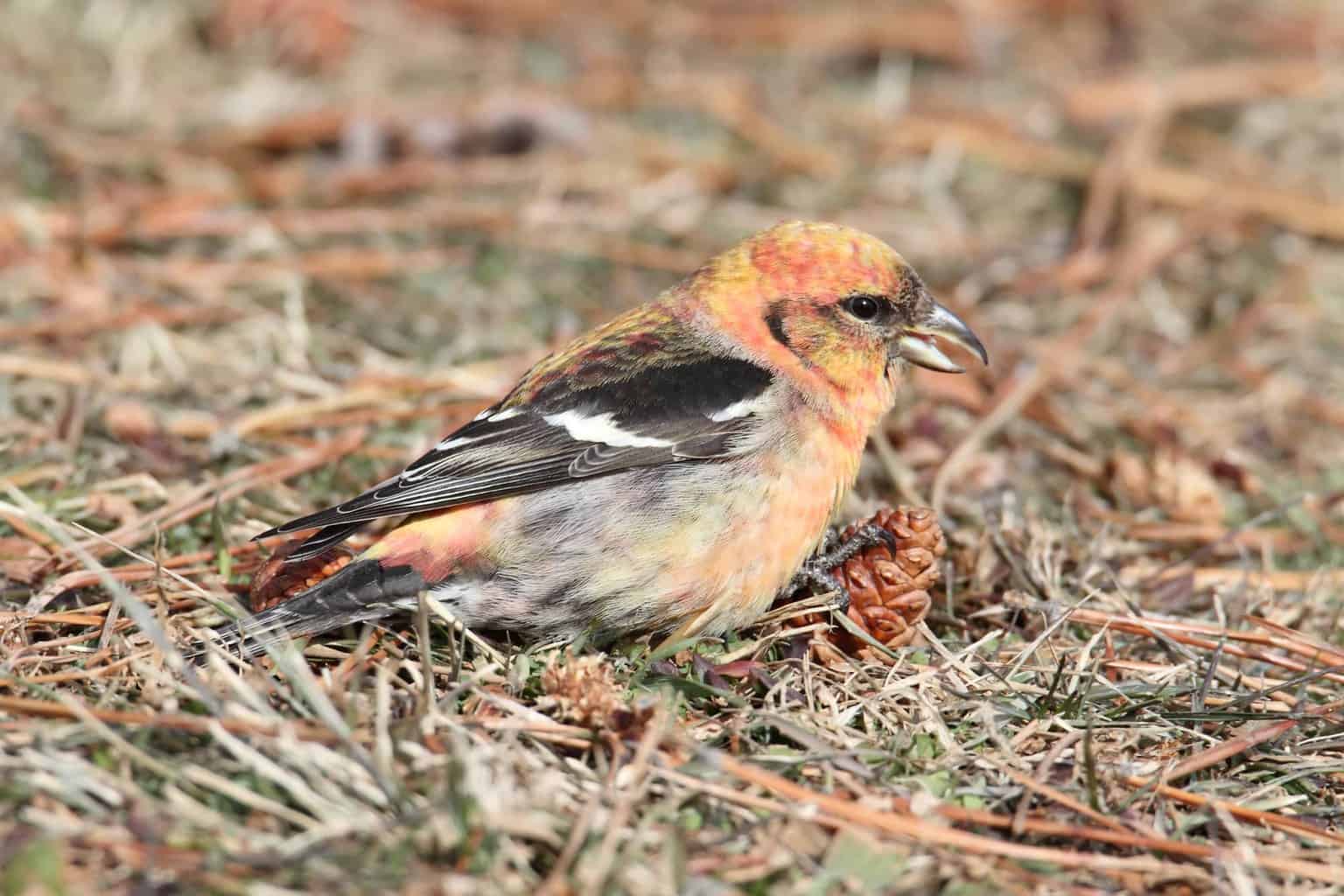Wisconsin is a land of marshes, dense forests, and hill country.
Minnesota’s southwestern neighbor is also home to rivers and lakes, several of which were formed over several ice ages by northern glaciers.
Here in the Badger state, red robins herald the arrival of spring, and Canada geese and tundra swans are just a few of the species that arrive in time to take over its lakes and waterways.
Depending on food sources, common redpolls might make an appearance further north. Such a variety of birdlife is hardly surprising in this state known for its freezing winters and mild summers.
There are 300 bird species in Wisconsin, 13 of which are those varied and adaptable passerines, finches.
And you can discover all you need to know about finches in Wisconsin right here, which will help you recognize members of this vast, much-loved family and admire their antics at your garden feeder!
American Goldfinch

- Scientific Name: Spinus tristis
- Length: 4.3 – 5.5 inches
- Weight: 0.4 – 0.7 ounces
- Wingspan: 7.5 – 9 inches
Known for being the only member of their species to molt biannually, American goldfinches can be recognized by a black cap which forms a striking contrast against their bright golden plumage, and dark wing feathers interrupted by slashes of white.
Those rather vibrant colors can only be found in males and give way to a more muted olive with the arrival of fall.
Females exhibit the same barred pattern on their wings but are olive and brown with hints of yellow everywhere else.
American goldfinches can be found in Wisconsin throughout the year – particularly in the southern part of the state.
These monogamous birds are equally at home in urban areas and in the wild, where they have learned to take full advantage of the bounty provided by bird feeders and the seeds of black oil and saw-toothed sunflowers.
Lesser Goldfinch

- Scientific Name: Spinus psaltria
- Length: 3.5 – 4.7 inches
- Weight: 0.3 – 0.4 ounces
- Wingspan: 6 – 11 inches
A smaller relative of the American goldfinch, the lesser goldfinch shares the same black cap, golden coloring, and barred wing and tail feathers as its larger cousin.
However, its upper surface may also be black or olive, rendering it less radiant than the American goldfinch. Female birds are colored olive and brown with hints of yellow
The lesser goldfinch, which is actually considered to be the smallest variety of finch, is equally at home in arid areas and pine forests and prefers to stay close to sources of water.
It is especially fond of sunflower and thistle seeds and is known for being acrobatic.
The lesser goldfinch rarely visits Wisconsin, preferring to live in western California, southeastern Arizona, southern New Mexico, and Texas, as well as Mexico.
Brambling

- Scientific Name: Fringilla montifringilla
- Length: 6 inches
- Weight: 0.8 – 1.02 ounces
- Wingspan: 10 inches
A migratory species, the brambling is known to winter in Asia (China, India, Japan, and Pakistan), North Africa, and Southern Europe. In addition to breeding in Europe, it also makes an occasional appearance in North America (Wisconsin included) and Canada.
The male of the species can be recognized by plumage which is mostly gray blended with orange, is black at the head, and a pale orange at the throat, subsequently darkening at the breast. Its plumage at the mantle is a beautiful scalloped black edged with orange. It turns to an alternating black, orange, and black at its coverts, and bold strokes of alternating black and orange with a touch of white at its rump.
During its rare winter incursions into Wisconsin, the brambling can be seen in its North Woods, that vast expanse of boreal forest found in the north-central part of the state, home to 3,200 lakes, and an abundance of streams and rivers.
The brambling is often mistaken for the chaffinch although the latter’s plumage has a rather reddish tint as opposed to the rust-colored plumage of the former. The chaffinch’s bill is rather gray or cream while the brambling’s is yellow tipped with black.
Common Redpoll

- Scientific Name: Acanthis flammea
- Length: 4.5 – 5.5 inches
- Weight: 0.4 – 0.6 ounces
- Wingspan: 8 – 9 inches
These compact small avians can be recognized by the presence of a dark red patch which is present on the crown in both genders and a plumage covered in dark brown streaks against pale gray.
Both male and female birds also have short yellow bills which end in dark tips. A dash of pink is however present on the throat and belly of the male.
Although they prefer to breed and live in Northern Canada (Nunavut, the North West Territories) and northern Alaska, redpolls occasionally move further south.
These beautiful finches may visit Wisconsin in the winter in search of their favorite birch and alder seeds. Common redpolls tend to live in maple or birch forests, farmland, grassland, and urban areas in every part of the state.
Hoary Redpoll

- Scientific Name: Acanthis hornemanni
- Length: 5 – 5.5 inches
- Weight: 0.40 – 0.50 ounces
- Wingspan: 8 – 10 inches
These close relatives of the common redpoll are somewhat more robustly built than their cousins.
They also exhibit the same dark red coloring on the crown, although their plumage is a lighter hue compared to common redpolls. Males exhibit a more uniform plumage with a hint of pink at the breast while the presence of streaks is more pronounced in females.
Hoary redpolls are even more frost tolerant compared to their more slightly built relatives and breed in northern Alaska and the islands of the Arctic between May and July. Their small nests are built from twigs and lined with feathers and fur, occurring in close proximity to each other.
Hoary redpolls rarely visit Wisconsin. However, they may arrive in the company of common redpolls settling down in birch or maple forests, farmland, or grassland, in the northern and central areas of the state.
House Finch

- Scientific Name: Haemorhous mexicanus
- Length: 6 inches
- Weight: 0.6 – 0.9 ounces
- Wingspan: 10 inches
House finches are mid-sized finches covered in light brown plumage marked by distinctive streaks in a darker brown.
Males of the species also exhibit a splash of pink at the crown, throat, and breast.
These rather adaptive and especially resilient birds once occupied the western United States, known for its Mediterranean climate.
Now they can be found in the semi-arid southwest, the subtropical south, the humid continental Midwest and Great Lakes regions, and even tropical Hawaii.
House finches can be found throughout the state of Wisconsin and prefer to live in croplands or urban areas where they flock to avail themselves of the abundance provided by backyard bird feeders.
They can be somewhat belligerent when food is involved and have been known to fight off house sparrows whose numbers (along with purple finches’) inevitably decline whenever house finches move into an area they occupy.
Pine Siskin

- Scientific Name: Spinus pinus
- Length: 4.3 – 5.5 inches
- Weight: 0.4 – 0.6 ounces
- Wingspan: 7 – 9 inches
Something of a cross between a goldfinch and a sparrow, the pine siskin exhibits a plumage that is brown at the head and barred at the nape. At the breast, a pale background patterned with darker brown stripes dominates, while its coverts are black fringed with yellow, and its tail is yellow and black.
This species is an occasional summer visitor to Wisconsin. It also visits in the winter and can be found all over the state.
It occupies deciduous woods, swamps, bogs, and urban areas, and congregates in flocks to feed on alder, birch, thistle, and sunflower seeds. Pine siskins are also partial to nectar, buds, and aphids.
This acrobatic finch which is capable of hanging upside down also nests in Wisconsin. Its nest is generally shallow and the bird prefers to conceal it in the foliage of its tree of choice.
Purple Finch

- Scientific Name: Haemorhous purpureus
- Length: 4.7 – 6.3 inches
- Weight: 0.63 – 1.10 ounces
- Wingspan: 10 inches
In keeping with its name, the male of the species can be recognized by its plumage which is completely pink at the head and flushed with hints of rose everywhere else.
The female, on the other hand, is covered with pale-colored feathers marked with brown streaks.
The purple finch is present in Wisconsin during summer and winter and also breeds within the state. It can be found throughout Wisconsin including the Southern Savannah, the Central Sands Prairie, and regions around Lake Michigan, and Lake Superior.
The species is also present along the Pacific Coast from Washington in the north to California in the south. While conspicuously absent from central states it can also be found in Michigan and New York.
The purple finch enjoys a varied diet of berries, elm seeds, and insects. It prefers to breed in coniferous forests and its designated areas for the purpose extend in a broad swathe from British Columbia in western Canada to Quebec in the east, dipping slightly southwards into northern Minnesota.
Evening Grosbeak

- Scientific Name: Hesperiphona vespertina
- Length: 6 – 9 inches
- Weight: 1.3 – 3.0 ounces
- Wingspan: 12 – 14 inches
A rather large-sized finch, the evening grosbeak can be recognized by plumage which is brown at the head interrupted by a thick “W” shaped ridge of yellow above the eyes. Those brown head feathers lighten to a brownish-yellow at the nape, throat, and breast, and yellow at the belly and upper surface. They subsequently darken to black at the wings where they are interrupted by a prominent dash of white.
The evening grosbeak is a regular visitor to northern and central Wisconsin where it can be found close to Lake Superior, Lake Michigan, and in the Central Sands Prairie.
The species is especially fond of feeding on ash, box elder, and maple seeds, It is also rather partial to maple sap. Bird feeders are believed to have played a key role in the eastward expansion of this species.
Gray-Crowned Rosy Finch

- Scientific Name: Leucosticte tephrocotis
- Length: 5 inches
- Weight: 0.8 – 2 ounces
- Wingspan: 13 inches
Named for the flush of pink that suffuses its mostly dark bronze plumage which turns gray at its head, the gray-crowned rosy finch is a medium-sized bird known for being especially gregarious.
This species often occurs in Wisconsin as a migrant and may be seen in urban areas. The gray-crowned rosy finch prefers to breed in British Columbia, Alberta, Washington, and Montana. It may also breed as far north as Alaska.
Pine Grosbeak

- Scientific Name: Pinicola enucleator
- Length: 8 – 10 inches
- Weight: 2 – 3 ounces
- Wingspan: 13 inches
The male pine grosbeak is covered in plumage which is mostly a beautiful rose, and which turns slightly gray at the chest. The feathers of its wings are black, edged with white while its short beak is a dark gray.
The female on the other hand is mostly gray with the exception of her head which is a yellowish olive.
The species that can regularly be seen in Wisconsin in winter prefers coniferous and deciduous woods and may also be seen in swamps or urban areas.
The pine grosbeak prefers the company of its kind when feeding and is especially fond of berries, seeds, and insects.
Red Crossbill

- Scientific Name: Loxia curvirostra
- Length: 7.9 inches
- Weight: 2 ounces
- Wingspan: 12 inches
This species is named for the male which can be recognized by plumage partly consisting of a beautiful russet to varying degrees with the rest being a dark gray-brown, its wings included.
Females on the other hand also exhibit the same dark coloration on their wings although this somber coloration is interrupted elsewhere by the presence of russet feathers.
The beaks of both genders are short and dark gray, with the upper crossed over the lower. This unique feature makes it possible for them to prise pine cones open with ease.
Although the red crossbill does not visit Wisconsin frequently during summer, it does during winter and can be seen around Lake Superior and the northern part of the state in general, the Central Sands Plains, and the southeast.
White-Winged Crossbill

- Scientific Name: Loxia leucoptera
- Length: 5.7 – 6.7 inches
- Weight: 0.9 – 1.40 ounces
- Wingspan: 11 inches
The male of this species is covered in vivid red plumage interrupted by dark-colored wings against which dashes of white stand out.
Females on the other hand are covered in grayish-brown plumage with a smattering of bronze at the throat, neck, and head.
Both genders have the same short dark crossed bill which is ideal for opening spruce seeds and those of other conifers.
Although white-winged crossbills can be found in northern and central Wisconsin, in the North Woods, and Central Sands Prairie regions, they also occasionally move as far south as Illinois.
Conclusion
Wisconsin’s rather impressive variety of finch species means it is filled with endless opportunities for observing them.
Included in that list are regular visitors such as the American goldfinch with its radiant plumage, the rose-colored purple finch, and the robust evening grosbeak.
Also included are the striking pine grosbeak and the russet-feathered red crossbill which brighten up snowy winters.
These nimble passerines also get to share the Badger State with other feathered residents. We have also provided all you need to know about the many beautiful birds in Wisconsin so you can discover what lies in store during your birdwatching adventures in Iowa’s northeastern neighbor.

